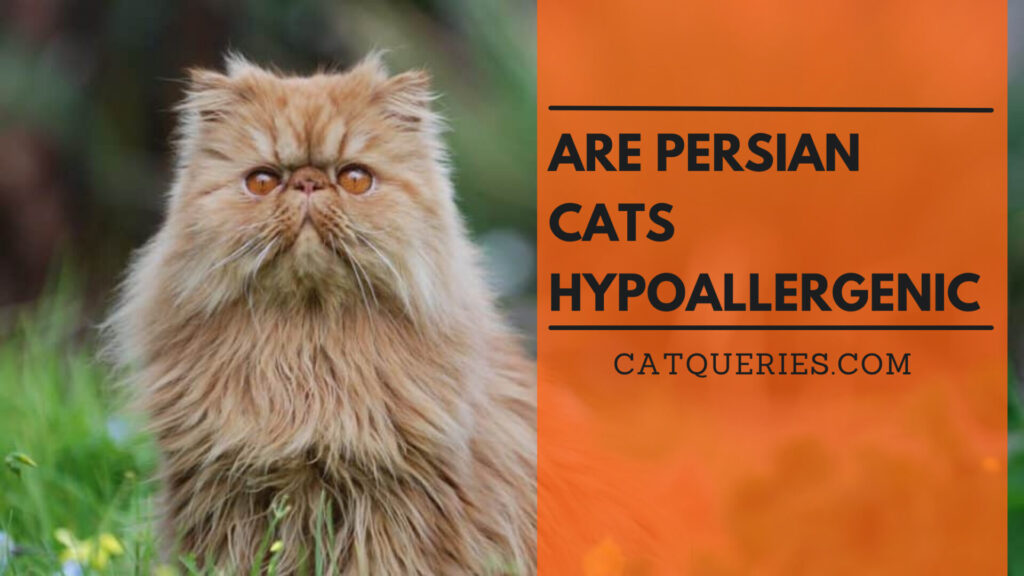If you’re someone who loves Persian cats but suffers from allergies or sensitivities, this article is for you. Throughout this article, you will learn about how to manage and deal with allergies and sensitivities specifically related to Persian cats. We will explore various tips and techniques that can help you enjoy the company of these beautiful felines without compromising your health. So, if you’ve been wondering about ways to still have a Persian cat in your life despite your allergies, keep reading to find out more!
Dealing with Allergies and Sensitivities to Persian Cats
Persian cats are known for their luxurious fur and sweet demeanor, making them a popular choice for cat lovers around the world. However, their long and dense coat can also contribute to allergies and sensitivities in some individuals. In this article, we will explore the causes of allergies and sensitivities to Persian cats, how to identify allergic reactions, and various strategies for managing and living with these conditions.
Overview of Persian Cats
Physical Characteristics
Persian cats are characterized by their long and flowing coat, round face, and expressive eyes. Their fur can come in a variety of colors and patterns, including solid, tabby, and pointed. This breed has a distinctive body structure, with a cobby body, short legs, and a broad chest. Persian cats have a sweet and gentle temperament, making them excellent companions.
History and Origins
The Persian cat breed is believed to have originated in Persia (modern-day Iran) and has a rich history spanning several centuries. They were highly esteemed in ancient Persia and were even considered sacred. Persian cats were introduced to Europe in the 17th century and began gaining popularity among cat fanciers. Over the years, different variations of the breed emerged, resulting in the Persian cat we know today.
Personality Traits
Persian cats are known for their calm and gentle nature. They tend to be reserved and prefer a quiet and peaceful environment. These cats are affectionate and form strong bonds with their human companions. Persians thrive on routine and do best in homes with a stable and predictable daily schedule. Despite their calm demeanor, they still enjoy playtime and interactive toys.
Understanding Allergies and Sensitivities
Difference between Allergies and Sensitivities
Allergies and sensitivities to Persian cats are often used interchangeably, but they refer to different reactions in the body. Allergies are an immune response triggered by exposure to certain substances, known as allergens, such as cat dander or saliva. Sensitivities, on the other hand, are a non-immune response to a substance and are often milder than allergies. While both can cause discomfort and symptoms, allergies are typically more severe.
Common Symptoms of Allergies to Cats
Allergies to Persian cats can manifest in various ways. Common symptoms include:
- Sneezing
- Itchy and watery eyes
- Runny or congested nose
- Coughing or wheezing
- Skin rashes or hives
- Itchy or irritated skin
- Difficulty breathing
It’s important to note that not everyone will experience the same symptoms, and the severity can vary from person to person.
Causes of Allergies and Sensitivities
Allergies and sensitivities to Persian cats are primarily caused by the presence of allergens in their dander, urine, and saliva. These microscopic particles can become airborne and easily spread throughout the environment, triggering a reaction in susceptible individuals. The primary allergen associated with cat allergies is a protein called Fel d 1, which is found in the cat’s skin and saliva. When cats groom themselves, they spread this allergen onto their fur, which can then be transferred to furniture, carpets, and other surfaces.

Identifying Allergic Reactions to Persian Cats
Skin Reactions
One of the telltale signs of an allergic reaction to Persian cats is skin irritation. People with allergies may develop redness, itching, or a rash when they come into contact with the cat’s fur or dander. These reactions can also be accompanied by hives or eczema-like symptoms. If you notice any abnormalities on your skin after interacting with a Persian cat, it may be an indication of an allergic reaction.
Respiratory Symptoms
Respiratory symptoms are common in individuals with allergies to Persian cats. Sneezing, a runny or congested nose, and coughing are typical signs that your body is reacting to the allergens present in the cat’s environment. Some people may also experience shortness of breath or chest tightness, especially if they already have existing respiratory conditions such as asthma.
Eye and Nasal Symptoms
Allergies to Persian cats often affect the eyes and nasal passages. Itchy, watery, and red eyes are common ocular symptoms, while a runny or stuffy nose can indicate nasal allergies. These symptoms can be particularly bothersome and significantly impact your daily activities if left unmanaged.
Managing Allergies and Sensitivities to Persian Cats
Prevention Techniques
Preventing allergic reactions in individuals with sensitivities to Persian cats can be challenging, but there are steps you can take to minimize exposure to allergens. Consider implementing the following prevention techniques:
- Designate cat-free zones in your home, such as bedrooms or certain furniture.
- Install high-efficiency particulate air (HEPA) filters in your home’s ventilation system to trap allergens.
- Encase mattresses, pillows, and furniture with allergen-proof covers.
- Use hypoallergenic bedding and wash it regularly in hot water.
- Limit direct contact with the Persian cat, especially avoiding cuddling or letting them sleep on your bed.
Regular Cleaning and Grooming
Regular cleaning and grooming can help reduce the presence of allergens in your home. Here are some cleaning tips:
- Vacuum your home frequently, using a vacuum with a HEPA filter.
- Use a damp cloth to wipe down surfaces and furniture, as it helps trap loose allergens.
- Wash bedding, curtains, and other fabrics regularly in hot water to eliminate allergens.
- Brush your Persian cat’s fur daily to reduce the amount of loose hair and dander.
- Consider using a pet-specific shampoo designed to minimize allergens when bathing your cat.
Air Purification and Filter Systems
Investing in an air purifier or filter system can significantly improve air quality and reduce allergens circulating in your home. Look for purifiers with HEPA filters, as they are effective at trapping microscopic particles like cat dander. Place the purifier in the rooms where you spend the most time to maximize its benefits.

Medical Treatments for Allergies and Sensitivities
Antihistamines and Decongestants
Antihistamines and decongestants are commonly used to manage the symptoms of allergies to Persian cats. Antihistamines work by blocking the effects of histamine, a chemical released by the immune system during an allergic reaction. Decongestants help relieve nasal congestion and reduce inflammation in the nasal passages. These medications can provide temporary relief but do not address the underlying cause of allergies.
Immunotherapy
Immunotherapy, also known as allergy shots, is a long-term treatment option for individuals with severe allergies to Persian cats. It involves receiving regular injections of gradually increasing amounts of the allergen, in this case, Fel d 1 protein. Over time, the body becomes desensitized to the allergen, reducing or eliminating allergic reactions. Immunotherapy requires a commitment of several years but can provide significant and long-lasting relief.
Prescription Medications
In some cases, prescription medications may be necessary to manage allergies and sensitivities to Persian cats. These medications are typically prescribed by an allergist or immunologist and can include:
- Nasal corticosteroids: These nasal sprays help reduce inflammation in the nasal passages and relieve symptoms such as congestion and sneezing.
- Leukotriene modifiers: These medications block the effects of certain chemicals involved in the allergic response and can help alleviate symptoms.
- Corticosteroid creams or ointments: These topical treatments can help relieve skin rashes and itching caused by allergic reactions.
It is important to consult with a healthcare professional before starting any prescription medication to ensure they are appropriate for your situation.
Natural Remedies and Homeopathic Approaches
Air Quality Improvement
Improving indoor air quality is crucial for individuals with allergies to Persian cats. Some natural remedies to consider include:
- Opening windows to increase ventilation and fresh air circulation.
- Using natural air purifiers such as salt lamps or bamboo charcoal bags.
- Adding indoor plants that can help filter and purify the air, such as spider plants or aloe vera.
Allergen Reducing Products
Several products on the market claim to reduce allergens, including those from Persian cats. Some examples include anti-allergen sprays, laundry detergents, and allergen-blocking bedding. While these products may provide some relief, their effectiveness can vary, and it is important to read reviews and do thorough research before purchasing.
Herbs and Supplements
Certain herbs and supplements may have anti-inflammatory or immune-boosting properties, which could potentially help alleviate symptoms of allergies and sensitivities. However, it is crucial to consult with a healthcare professional before starting any new supplement regimen, as interactions and side effects can occur.

Hypoallergenic Persian Cats
Breeds with a Lower Allergenic Potential
For individuals with severe allergies to Persian cats, hypoallergenic breeds may be a suitable option. These breeds are believed to produce fewer allergens than others, although it is important to note that no cat breed is completely hypoallergenic. Some breeds with a lower allergenic potential include:
- Siberian
- Balinese
- Russian Blue
- Devon Rex
- Cornish Rex
It is recommended to spend time with the specific breed you are considering to ensure you do not have a reaction before making a commitment.
Understanding Fel d 1 Protein
The primary allergen associated with allergies to Persian cats is a protein called Fel d 1. This protein is found in the cat’s skin and saliva and can easily become airborne, triggering allergic reactions in susceptible individuals. While there is currently no way to eliminate Fel d 1 protein entirely, certain breeding practices and individual variations may result in lower production of this allergen in some cats.
Tips for Choosing a Hypoallergenic Persian Cat
If you are considering getting a hypoallergenic Persian cat, here are some tips to help you make an informed decision:
- Spend time with the cat you are considering to ensure you don’t have an allergic reaction.
- Research breeders who specialize in hypoallergenic Persian cats and ask about their breeding practices.
- Consider getting an adult cat instead of a kitten, as adults produce the same amount of allergens throughout their lives.
- Consult with an allergist or veterinarian for specific advice and guidance based on your individual circumstances.
Creating an Allergy-Free Zone for Persian Cats
Designated Rooms and Spaces
Creating an allergy-free zone can provide relief for individuals with allergies to Persian cats. Consider designating certain rooms or areas in your home as cat-free zones, especially bedrooms or areas where you spend extended periods. This can help minimize exposure to allergens and provide a refuge for allergy sufferers.
Minimizing Contact with Allergens
Reducing direct contact with allergens is crucial for managing allergies to Persian cats. Here are some tips to minimize exposure:
- Wash your hands thoroughly after interacting with your Persian cat.
- Avoid touching your face or rubbing your eyes while in contact with the cat.
- Change and wash your clothes after spending time with the cat to remove any allergens.
- Consider using a high-efficiency vacuum cleaner specifically designed to capture allergens.
Frequent Cleaning and Vacuuming
Regular and thorough cleaning is essential for creating an allergy-friendly environment. Some cleaning tasks to prioritize include:
- Vacuuming carpets, rugs, and upholstery at least once a week using a vacuum with a HEPA filter.
- Mopping hard floors with a damp mop to trap and remove allergens.
- Dusting surfaces with a damp cloth to prevent allergens from becoming airborne.
- Laundering bedding, curtains, and other textiles frequently in hot water.
- Cleaning your Persian cat’s litter box regularly to reduce allergens.

When Allergies Persist: Rehoming Options
Considering Rehoming as a Last Resort
If allergies to Persian cats persist and significantly impact your quality of life, rehoming the cat may become a consideration. However, rehoming should always be treated as a last resort after exhausting all other management options. It is important to remember that rehoming a pet is a serious decision and should be made with careful thought and consideration.
Finding Allergy-Friendly Homes
If rehoming becomes necessary, it may be possible to find allergy-friendly homes for Persian cats. Some individuals may have developed immunity or have milder allergies that can be managed with proper care. Seek out individuals or families who are specifically looking for a Persian cat and are aware of potential allergies. It is important to disclose the cat’s history and any known allergies to ensure a suitable match.
Organizations and Resources for Rehoming
There are various organizations and resources available to assist in rehoming Persian cats. Some examples include breed-specific rescue groups, online adoption platforms, and local animal shelters. These organizations can help facilitate the rehoming process and connect you with potential adopters who may be a good fit for your Persian cat.
Caring for a Persian Cat with Allergies
Special Dietary Needs
In addition to managing allergies in individuals, Persian cats themselves may also have dietary sensitivities or allergies. It is important to provide a balanced and appropriate diet that meets their nutritional needs while avoiding potential allergens. Consult with a veterinarian to determine the best diet for your Persian cat and to address any known allergies or sensitivities.
Regular Vet Check-ups
Regular veterinary check-ups are crucial for monitoring the overall health of your Persian cat, especially if they have known allergies or sensitivities. Routine check-ups allow the vet to assess any changes in symptoms or potential triggers and provide appropriate management strategies. It is also an opportunity to discuss any concerns you might have and ensure your cat’s well-being.
Understanding Triggers and Managing Symptoms
Understanding the triggers that worsen allergies or sensitivities in your Persian cat is key to managing their symptoms effectively. Keep a log of any changes in their environment, diet, or behavior that coincide with flare-ups. This can help identify potential allergens or irritants that should be avoided or minimized. Working closely with a veterinarian can help develop a personalized management plan tailored to your Persian cat’s specific needs.

Raising Awareness and Educating Others
Informing Family and Friends
If you have allergies to Persian cats, it is important to inform your family and friends about your condition. Educate them about the potential triggers and symptoms, and explain the measures you are taking to manage your allergies. This will help create an allergy-aware environment and minimize the risk of allergen exposure when you visit or spend time with loved ones.
School and Workplace Discussions
If you have children with allergies to Persian cats or if you yourself have allergies, it may be necessary to have discussions with their school or your workplace about potential allergen exposure. Inform teachers, administrators, or human resources about the allergies, and request accommodations or protocols to minimize exposure to cat allergens. This can include specific cleaning practices or designated allergy-free areas.
Online Communities and Support Groups
Online communities and support groups can provide valuable resources and a sense of community for individuals managing allergies and sensitivities to Persian cats. Connect with others who share similar experiences, exchange tips and advice, and find support during challenging times. These communities can be a source of comfort and understanding for those navigating life with cat allergies.
Addressing Common Myths and Misconceptions
Persian Cats as Highly Allergenic
One common myth is that Persian cats are highly allergenic. While it is true that Persian cats produce Fel d 1 protein, which can trigger allergies, each individual’s sensitivity can vary. Some individuals may find that they are not allergic to Persian cats specifically, while others may experience symptoms even with hypoallergenic breeds. Understanding individual differences and evaluating personal reactions is crucial when assessing allergenic potential.
Eliminating Allergens Completely
Another misconception is that it is possible to completely eliminate allergens from your environment. While various strategies can help minimize allergens in your home, it is nearly impossible to eliminate them entirely. Allergens can remain in the air and on surfaces even with thorough cleaning and grooming practices. It is important to set realistic expectations and focus on managing symptoms rather than striving for complete elimination.
Alternative Cat Breeds for Allergy Sufferers
Some individuals may believe that certain cat breeds are completely hypoallergenic and safe for allergy sufferers. While hypoallergenic breeds may produce fewer allergens, no cat breed is entirely hypoallergenic. Allergies are subjective, and individuals can react differently even within the same breed. It is important to spend time with specific cats to assess your personal reaction before making any commitments.
Seeking Professional Help for Allergies
Consulting an Allergist
If you suspect you have allergies or sensitivities to Persian cats, it is important to consult an allergist for proper diagnosis and management. Allergists are medical professionals specialized in identifying and treating allergies. They can perform tests, such as skin prick tests or blood tests, to determine if you are allergic to cats or other allergens and provide appropriate treatment options.
Allergy Testing and Diagnosis
Allergy testing is essential for accurately diagnosing allergies to Persian cats or other allergens. Skin prick tests involve placing small amounts of allergens, including cat allergens, on your skin and observing for a reaction. Blood tests can also measure specific antibodies associated with allergies. Based on the results, an allergist can provide a comprehensive diagnosis and recommend appropriate management strategies.
Developing Personalized Allergy Management Plans
Working with an allergist allows you to develop personalized allergy management plans tailored to your specific needs. These plans may include a combination of avoidance strategies, medication options, and potentially immunotherapy. An allergist can guide you through the process, provide ongoing support, and help you achieve the best possible quality of life while managing your allergies.
Conclusion
Dealing with allergies and sensitivities to Persian cats can be challenging, but with the right strategies and support, it is possible to live harmoniously with these beloved feline companions. Remember to consult with healthcare professionals, such as allergists and veterinarians, to ensure proper diagnosis and management. By implementing prevention techniques, maintaining a clean environment, and exploring various treatment options, you can enjoy the companionship of a Persian cat while minimizing allergic reactions and sensitivities.
